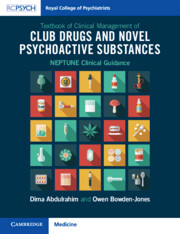 Textbook of Clinical Management of Club Drugs and Novel Psychoactive Substances
Textbook of Clinical Management of Club Drugs and Novel Psychoactive Substances Book contents
- Textbook of Clinical Management of Club Drugs and Novel Psychoactive Substances
- Textbook of Clinical Management of Club Drugs and Novel Psychoactive Substances
- Copyright page
- Contents
- Acknowledgements
- Part I Introduction and Background
- Chapter 1 An Introduction to Club Drugs and Novel Psychoactive Substances
- Chapter 2 Psychosocial Interventions for Club Drugs and Novel Psychoactive Substances
- Part II Drugs with Primarily Depressant Effects
- Part III Drugs with Primarily Stimulant Effects
- Part IV Drugs with Primarily Hallucinogenic Effects
- Part V Synthetic Cannabinoid Receptor Agonists
- Part VI Concluding Remarks
- Index
- References
Chapter 2 - Psychosocial Interventions for Club Drugs and Novel Psychoactive Substances
from Part I - Introduction and Background
Published online by Cambridge University Press: 06 October 2022
- Textbook of Clinical Management of Club Drugs and Novel Psychoactive Substances
- Textbook of Clinical Management of Club Drugs and Novel Psychoactive Substances
- Copyright page
- Contents
- Acknowledgements
- Part I Introduction and Background
- Chapter 1 An Introduction to Club Drugs and Novel Psychoactive Substances
- Chapter 2 Psychosocial Interventions for Club Drugs and Novel Psychoactive Substances
- Part II Drugs with Primarily Depressant Effects
- Part III Drugs with Primarily Stimulant Effects
- Part IV Drugs with Primarily Hallucinogenic Effects
- Part V Synthetic Cannabinoid Receptor Agonists
- Part VI Concluding Remarks
- Index
- References
Summary
There is a large body of evidence on the effectiveness of psychosocial interventions (PSIs) for the management of substance misuse problems, including national guidelines. It is therefore possible to make specific and robust recommendations.
- Type
- Chapter
- Information
- Textbook of Clinical Management of Club Drugs and Novel Psychoactive SubstancesNEPTUNE Clinical Guidance, pp. 22 - 36Publisher: Cambridge University PressPrint publication year: 2022


